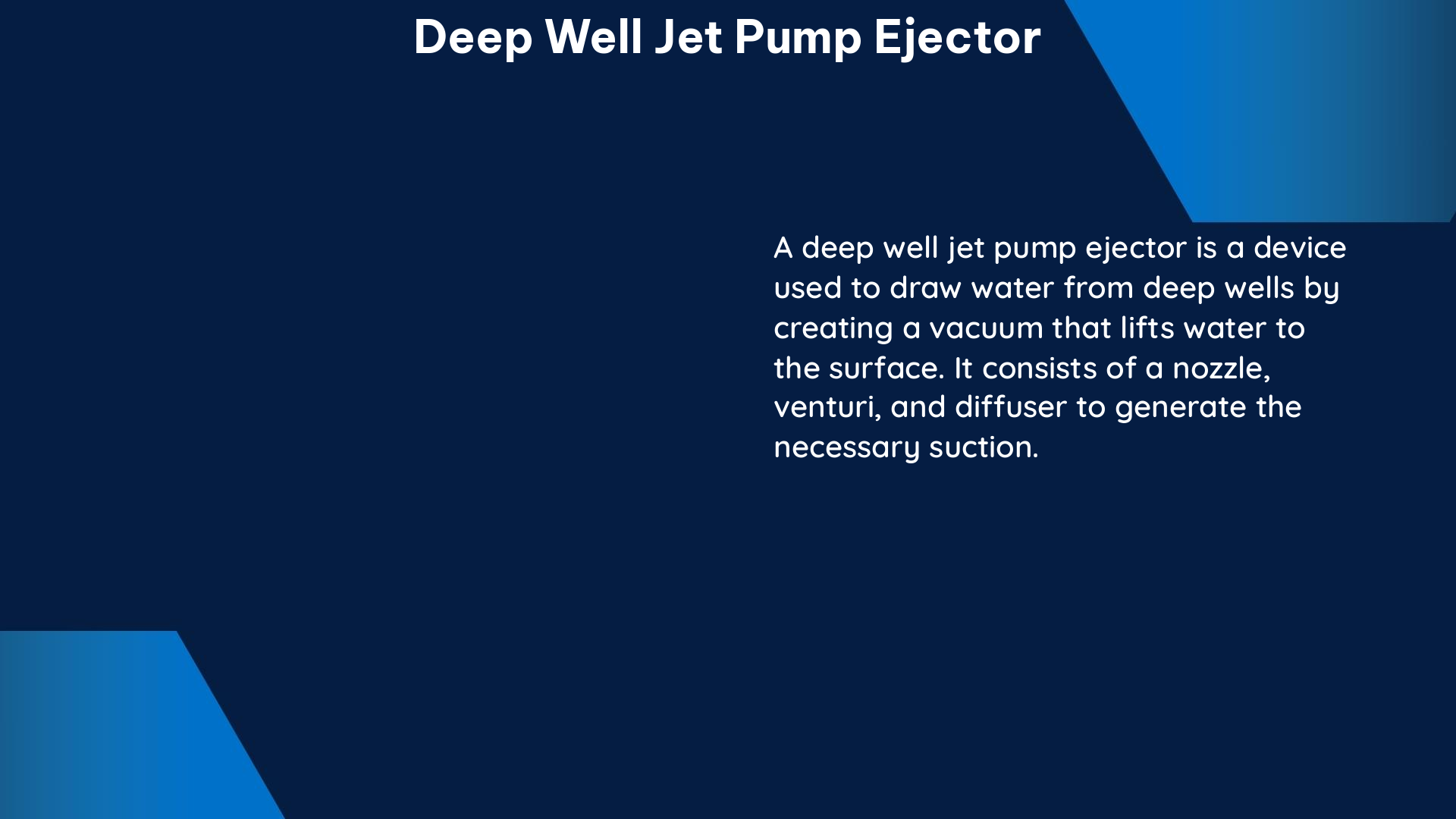A deep well jet pump ejector is a specialized device used to increase the pressure and flow rate of a low-pressure fluid source by utilizing the pressure energy of a high-pressure fluid stream. This device consists of a primary nozzle, a mixing chamber, and a diffuser, working together to create a powerful suction effect that can draw in and boost the low-pressure fluid.
Understanding the Key Parameters of a Deep Well Jet Pump Ejector
The performance of a deep well jet pump ejector can be quantified by several critical parameters:
- Pressure Ratio (PR): The ratio of the total pressure of the high-pressure fluid (P1) to the total pressure of the low-pressure fluid (P2), expressed as PR = P1/P2.
- Flow Ratio (FR): The ratio of the volume flow rate of the high-pressure fluid (Q1) to the volume flow rate of the low-pressure fluid (Q2), expressed as FR = Q1/Q2.
- Ratio of Mixing Tube-to-Nozzle Diameter (R): The ratio of the diameter of the mixing tube to the diameter of the primary nozzle, which is another important parameter.
These parameters are related through the equation:
PR = (1 + FR)^2 * (1 + (FR/R)^2)^(-C)
where C is the density ratio of the low-pressure fluid to the high-pressure fluid.
Calculating the Efficiency of a Deep Well Jet Pump Ejector

The efficiency of a deep well jet pump ejector can be calculated using the equation:
η = (PR – 1) / (1 + Kp + Ks + Kr + Kd)
Where:
– η is the efficiency of the ejector
– Kp, Ks, Kr, and Kd are the loss coefficients for the primary nozzle, secondary flow inlet, mixing chamber, and diffuser, respectively.
The typical values for these loss coefficients are:
– Kp = 0.05
– Ks = 0.10
– Kr = 0.15
– Kd = 0.20
These values are assumed for high Reynolds number applications (above 2 × 10^5).
Sizing the Primary Nozzle of a Deep Well Jet Pump Ejector
The primary nozzle of a deep well jet pump ejector can be sized using the equation:
D1 = (Q1 / CD * (2 * 9.81 * H)^0.5) / 1000
Where:
– D1 is the diameter of the primary nozzle (in meters)
– Q1 is the volume flow rate of the high-pressure fluid (in m^3/s)
– CD is the discharge coefficient of the nozzle (assumed to be 0.95 for a well-designed nozzle)
– H is the head difference between the inlet and outlet of the nozzle (in meters)
The nozzle should be conical with a half-angle of 5-10° and a parallel section at the nozzle outlet for improved mechanical strength.
Designing the Mixing Tube and Diffuser
The mixing tube of a deep well jet pump ejector should have a length of 7-10 diameters to ensure adequate mixing of the two fluid streams. The entry to the mixing tube should avoid large secondary flow losses by using a converging conical section or a bell-mouth entry.
The diffuser downstream of the mixing tube should have a narrow angle (typically 2-3° half angle) to reduce downstream pressure losses.
Installing a Deep Well Jet Pump Ejector
To install a deep well jet pump ejector, follow these steps:
- Locate the well: Ensure that the well is deep enough to accommodate the ejector and jet pump.
- Install the ejector: Install the ejector in the well, above the foot valve, and secure it to the well casing.
- Install the jet pump: Install the jet pump above ground, near the ejector, and secure it to a level surface.
- Connect the pipes: Connect the primary pipe from the jet pump to the ejector’s primary nozzle, and the secondary pipe from the ejector’s mixing chamber.
- Install the pressure switch: Install the pressure switch on the jet pump and set it to the desired pressure setting (e.g., 40-60 psi).
- Test the system: Turn on the jet pump and check for leaks. Ensure that the ejector is working properly and the jet pump is building pressure.
Remember to follow the manufacturer’s instructions carefully and test the system thoroughly before using it.
References
- Thermopedia. (n.d.). Jet pumps and ejectors. Retrieved from https://www.thermopedia.com/content/902/
- Efficiency of Jet Pumps. (n.d.). Retrieved from https://www.researchgate.net/publication/245296825_Efficiency_of_Jet_Pumps
- Deep Well Jet Pump Problems – Pump or Ejector? (2008, August 15). Retrieved from https://www.terrylove.com/forums/index.php

The lambdageeks.com Core SME Team is a group of experienced subject matter experts from diverse scientific and technical fields including Physics, Chemistry, Technology,Electronics & Electrical Engineering, Automotive, Mechanical Engineering. Our team collaborates to create high-quality, well-researched articles on a wide range of science and technology topics for the lambdageeks.com website.
All Our Senior SME are having more than 7 Years of experience in the respective fields . They are either Working Industry Professionals or assocaited With different Universities. Refer Our Authors Page to get to know About our Core SMEs.